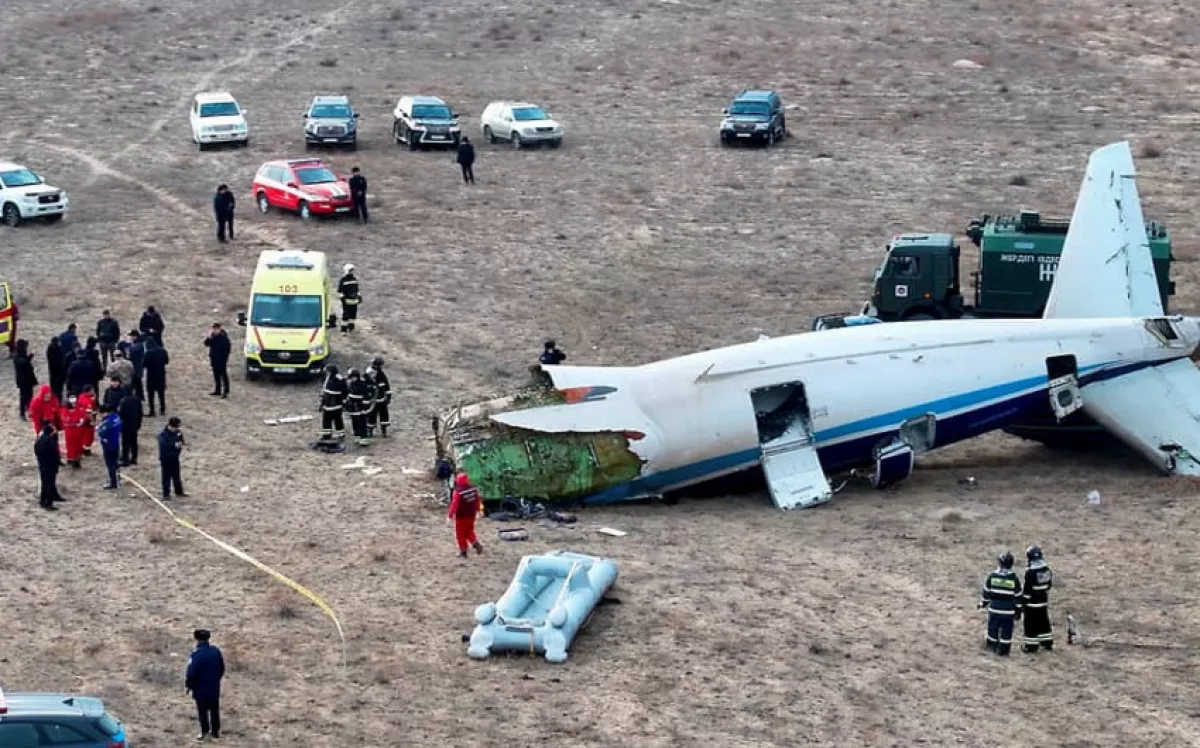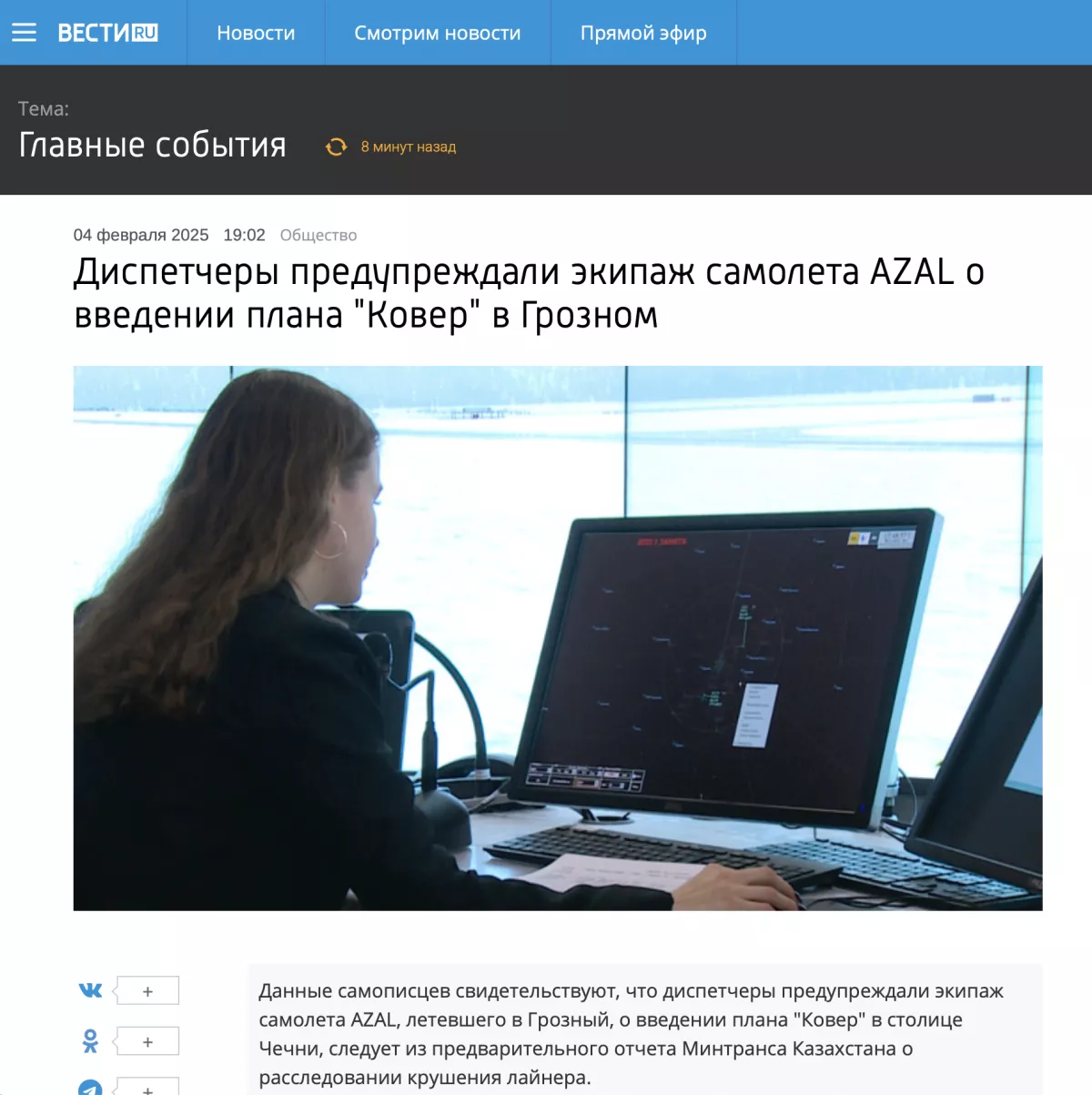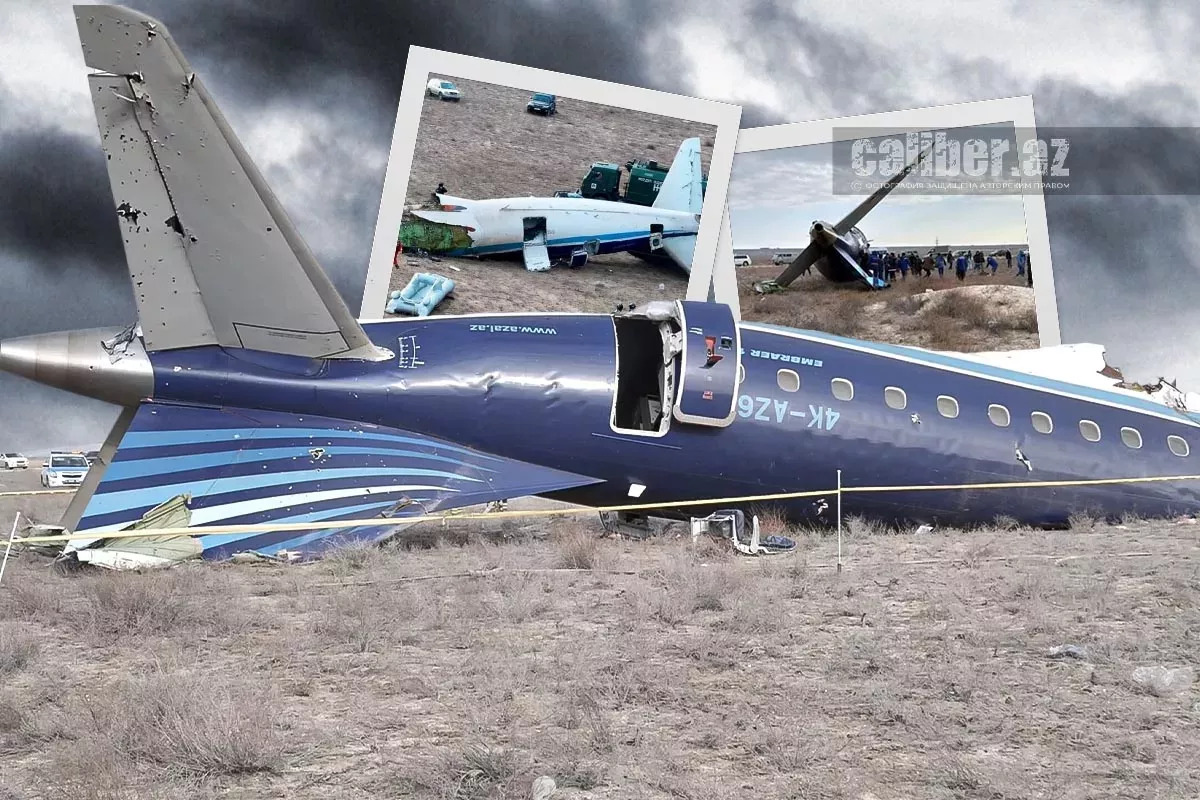Azerbaijani plane crash near Aktau: Investigation and uncomfortable facts Moscow evades responsibility
Recently, news emerged that added a new dimension to the discussion surrounding the crash of the Azerbaijan Airlines (AZAL) Embraer-190 aircraft near Aktau. The aircraft was operating a flight from Baku to Grozny. Kazakhstan's Ministry of Transport published a preliminary report on the investigation into the catastrophe.
As the country where the crash occurred, Kazakhstan initiated the investigation in accordance with Annex 13 of the Chicago Convention. Azerbaijan actively participated at all stages, including the site inspection, evidence collection, analysis of flight recorders, and examination of wreckage, including the aircraft's control mechanisms.
The investigation recorded clear signs of external impact on the aircraft. The preliminary report's findings also indicate that the aircraft was technically sound before the incident, with its engines operating without malfunctions. While in Russian airspace, the aircraft lost its GPS signal. Due to adverse weather conditions in Grozny, the crew was unable to make a second landing attempt and decided to return to Baku.
The analysis of black box data established the following sequence of events:
– At 05:13, two external sounds were recorded, 24 seconds apart.
– Four seconds after the first sound, the third hydraulic system failed; six seconds later, the first system failed; and 21 seconds later, the second system also failed.
– The fuselage was found to have punctures and severe damage near the stabilisers, the left wing, and the engine.
– The report states that the damage was caused by external objects.
The examination ruled out the possibility of a bird strike. Moreover, metallic fragments unrelated to the aircraft were discovered. Some of these fragments were extracted from Hydraulic System No. 3’s compartment and the stabiliser control mechanism. The report includes examples of other recovered metallic objects.
According to Reuters, in a report published on February 4, the Azerbaijani passenger aircraft was struck by a Russian Pantsir-S air defence system. A source in the Azerbaijani government confirmed to the agency: "The Azerbaijani side possesses a fragment of a Pantsir-S missile which was extracted from the aircraft and identified through international expertise."
This finding fully corroborates earlier reports by Caliber.Az, which stated that the aircraft was shot down by a Russian Pantsir-S system.
Russian media claim that the “Carpet” plan (the closed-airspace protocol) had allegedly been announced in advance, but the facts suggest otherwise. According to the published report, at 05:13, the aircraft lost its primary control systems. Only several minutes later did Russian communications first mention the “Carpet” plan.
It is important to emphasise that the aircraft’s crew was not informed about this plan—neither before the tragedy nor after the strike on the aircraft. Moreover, until 05:21, discussions about the “Carpet” plan remained internal communications within Russian services and were not relayed to the aircraft's crew. In other words, the Azerbaijani crew was never warned about the threat.

The work to establish a complete picture of the events is ongoing. However, one fact is already indisputable: the tragedy was caused by two key factors—the deliberate jamming of the GPS signal in Russian airspace, which led to the loss of precise navigation data and significantly complicated the crew’s operations, and the aircraft being struck by combat elements of a Russian air defence missile system, causing critical damage to the fuselage and control systems, ultimately leading to the disaster.
In light of these findings, the inevitable question arises—how will official Moscow, Russia’s specialised agencies, and the Russian media respond to the preliminary results of the investigation?
"The Kremlin does not comment on the preliminary report of Kazakhstan’s Ministry of Transport regarding the investigation into the crash of the AZAL airline aircraft," said Russian presidential press secretary Dmitry Peskov. "Of course, our relevant agencies will study it with great attention and due diligence. However, it is not possible to comment on this matter from the Russian presidential administration, and we do not consider it appropriate."
Meanwhile, Vesti.ru, a website operated by the All-Russia State Television and Radio Broadcasting Company (VGTRK), decided to go all-in by publishing an article with the sensational headline: "Air Traffic Controllers Warned the AZAL Crew About the Implementation of the 'Carpet' Plan in Grozny." This appears to be an attempt to offer a simplistic explanation for the cause of the disaster.

"The flight recorder data indicate that air traffic controllers warned the AZAL crew, en route to Grozny, about the implementation of the Carpet plan in the Chechen capital," insists the publication, citing the preliminary report from Kazakhstan’s Ministry of Transport on the crash investigation.
Well, let’s reiterate: the so-called warning was issued several minutes after the Pantsir-S air defence system had already engaged the aircraft. And it was directed only at Russian air traffic controllers—not the AZAL crew.
In this regard, a more substantive—if such a word can even be applied to Russia’s rhetoric—commentary was provided by Rosaviatsiya (Russia’s Federal Air Transport Agency). Let’s go through its key points one by one.
"The report is preliminary and does not contain conclusions about the causes of the incident. The commission’s work will continue, and the final report will present the conclusions on what happened,"—Russia immediately took a defensive stance, shielding itself from any responsibility at this stage.
But it gets even more interesting: "The preliminary report confirms that the aircraft sustained damage resulting from external impact. However, the report does not state that the Kazakh side identified foreign objects found in the aircraft. Russia has not had the opportunity to examine these elements since they have not been handed over for analysis."
Thus, the Russian side continues to deny the involvement of air defence systems in the aircraft's damage, citing the lack of physical evidence—or more specifically, the lack of access to this evidence. As mentioned earlier, the Azerbaijani side has confirmed that the foreign objects found on the aircraft are fragments from a Pantsir-S missile. The question now is: what will it take for Russia to acknowledge this fact?
Moreover, there is a surprising omission regarding the impact of Russia's electronic warfare (EW) system on the aircraft, which caused the GPS signal loss. That being said, it is noteworthy that Rosaviatsiya at least acknowledged that the damage was caused by external factors. Let’s remember this and continue.

"The report confirms previously reported information that the crew selected the alternative airport for landing, independently choosing Aktau. Despite the technical readiness of the alternative airports in Makhachkala and Mineralnye Vody, which could have accepted the aircraft, the crew did not opt for them," reads the statement from Rosaviatsiya.
Indeed, during the landing decision, the pilots considered not only the technical readiness of the airports to receive the aircraft but also the technical capability of the aircraft itself to land at the proposed locations. From this situation, one clear conclusion can be drawn—the pilots, after assessing the situation, deemed landing at the airports in Mineralnye Vody and Makhachkala to be too risky.
"The report about bird strikes and the explosion of an oxygen cylinder came from the crew of the Embraer. It was the AZAL pilots who transmitted this information to the Russian air traffic controllers," the agency continues to shift the blame onto the pilots.
This means that the Russian side is still clinging to the crew's assumptions as a lifeline. While Baku does not accuse Moscow of deliberately downing the aircraft, it is strongly urging Russia to take responsibility.
However, the very fact that the crew voiced two potential explanations—bird strikes and an oxygen cylinder explosion—indicates that these were mere speculations from the pilots, who could not have seen the actual source of the external impact on the aircraft.
From this perspective, Rosaviatsiya's comment contains a formal contradiction. On one hand, it acknowledges the fact of mechanical impact, yet on the other, it continues to push the theory of an oxygen cylinder explosion. In this situation, it would have made more sense to focus solely on the bird strike theory. But that would have made them look utterly absurd, as sooner or later, definitive evidence will emerge showing that the holes in the fuselage were caused by air defence systems. It seems that Rosaviatsiya had nothing better to do than dismiss the pilots' speculations without offering any further details.
The situation as it stands today clearly shows that it is becoming increasingly difficult for the Russian side to deny its involvement in the incident. So why drag this out? Baku will not back down from its already stated position, which is based on irrefutable facts.








